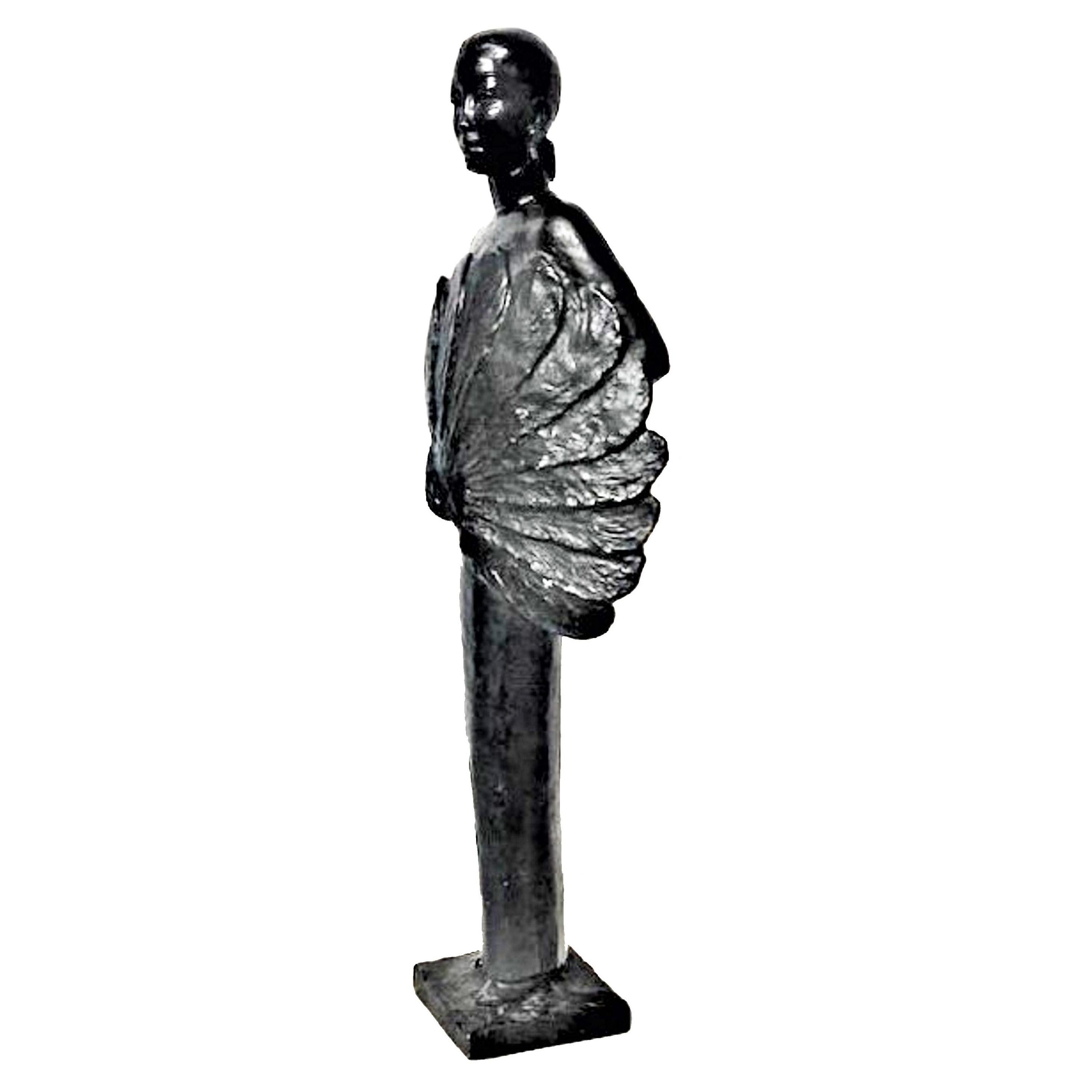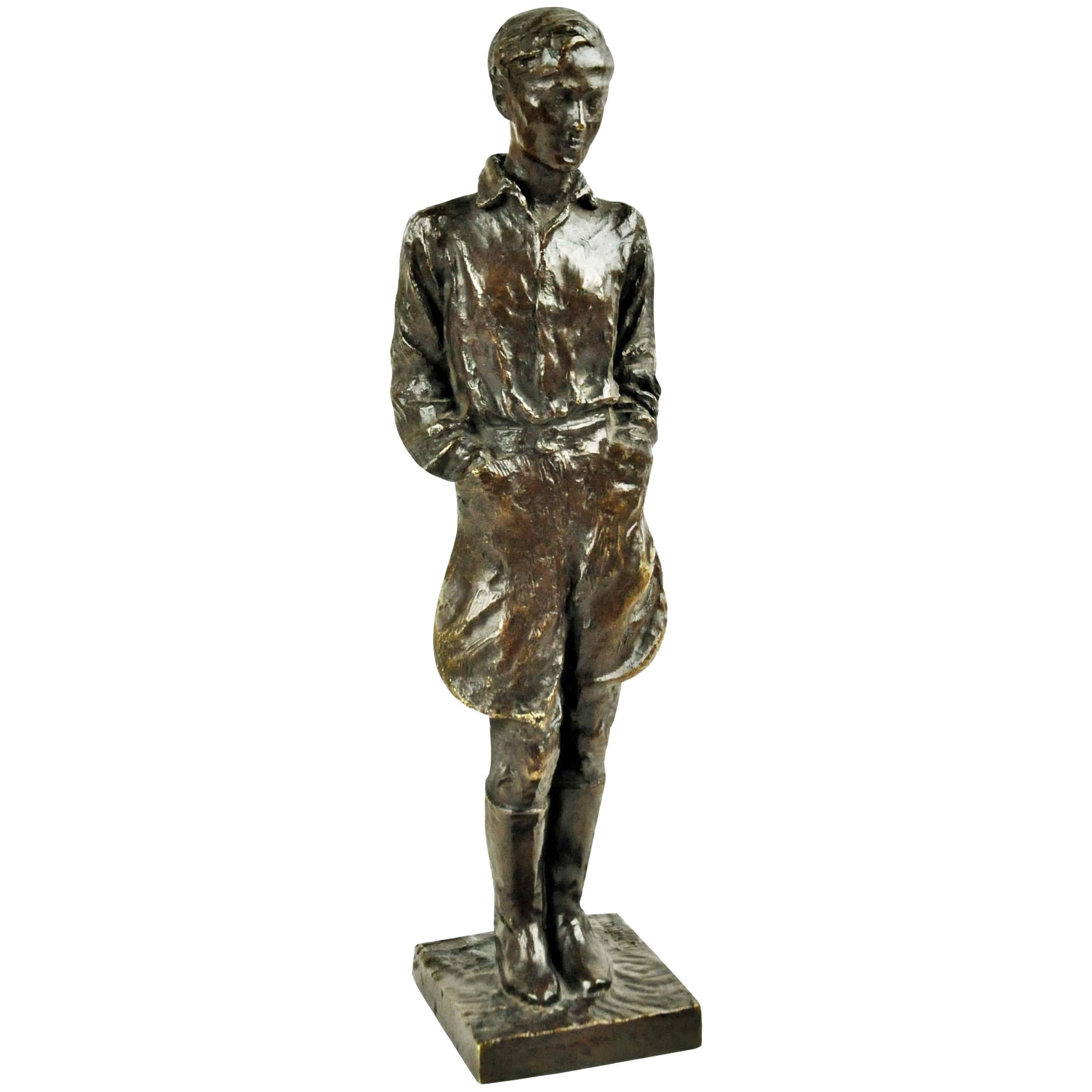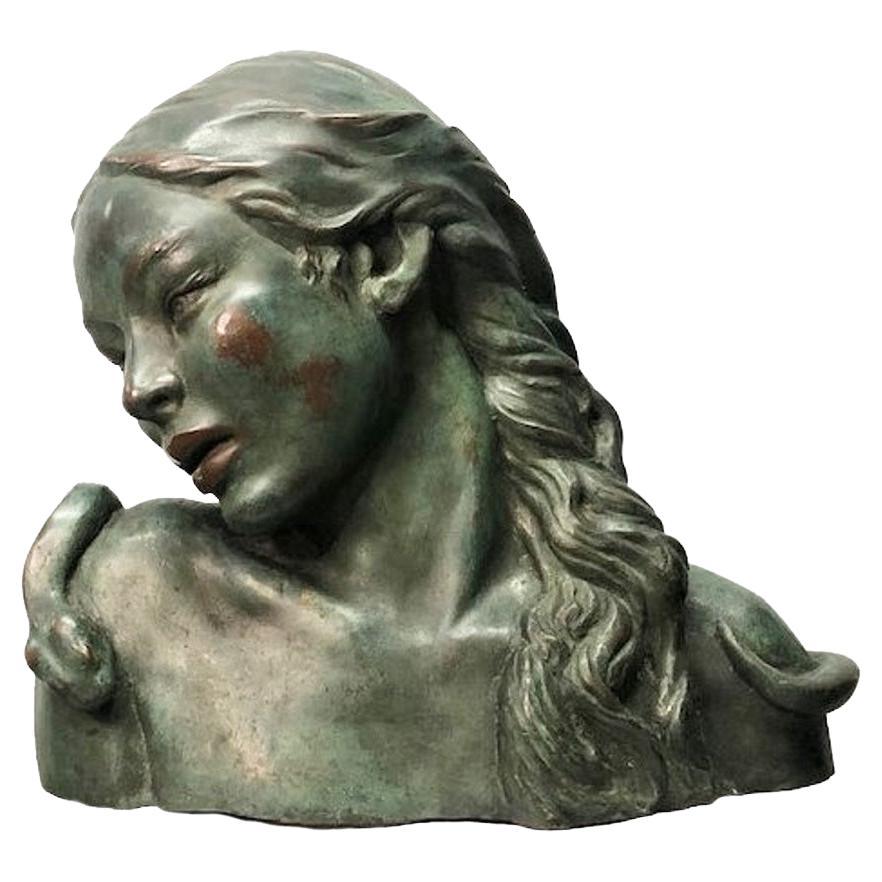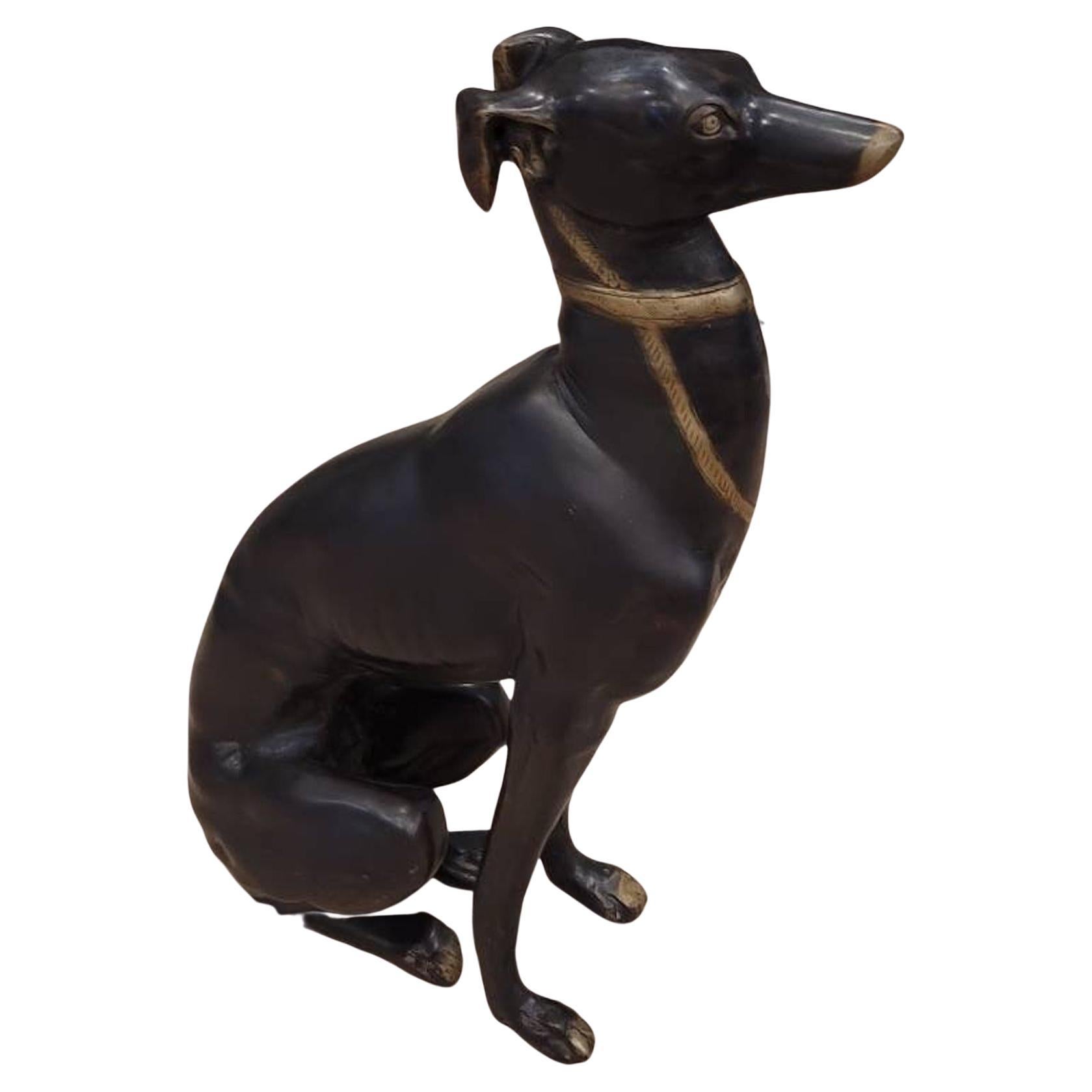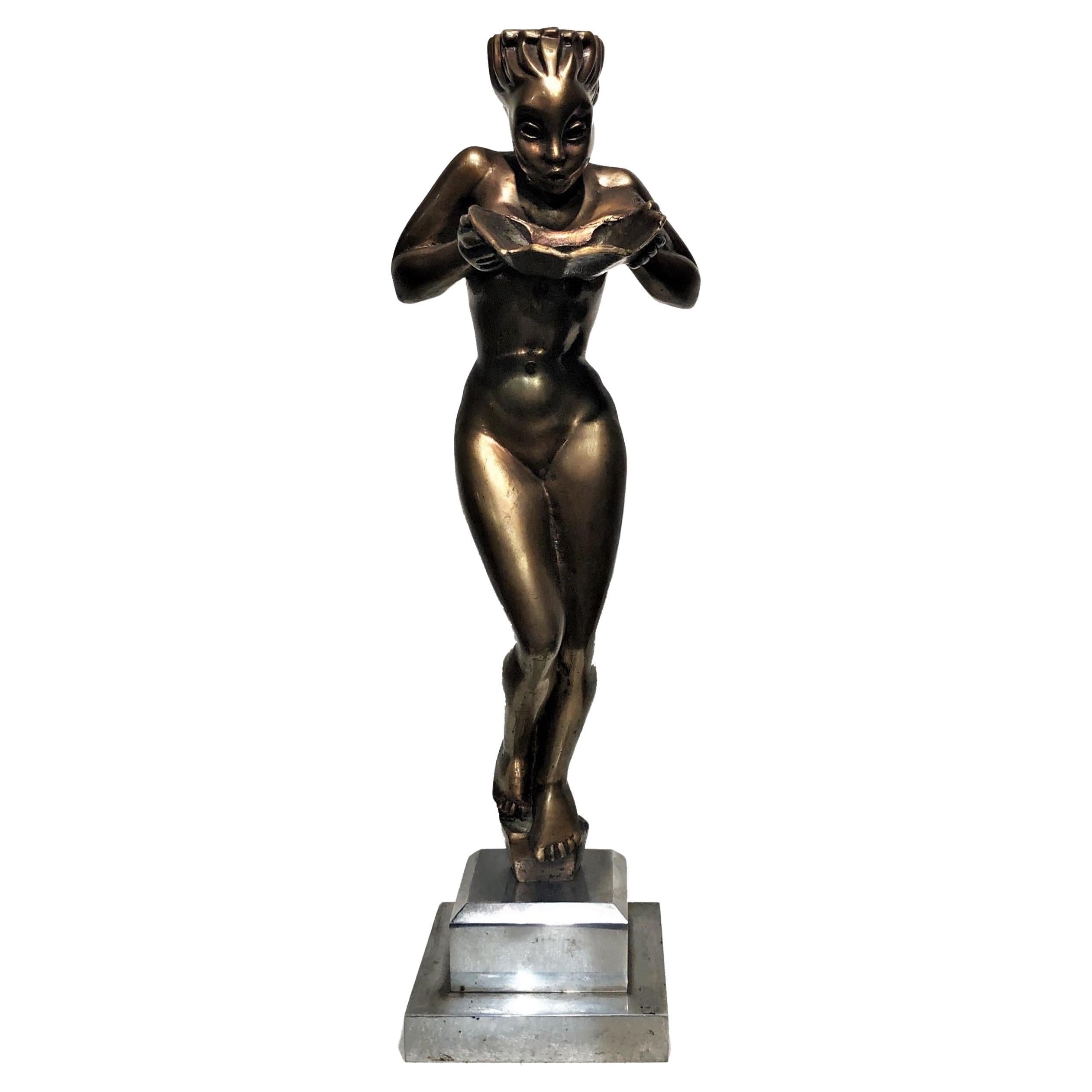Items Similar to Alexandre Zeitlin, Faerie, American Art Deco Patinated Bronze Sculpture, C. 1920
Want more images or videos?
Request additional images or videos from the seller
1 of 11
Alexandre Zeitlin, Faerie, American Art Deco Patinated Bronze Sculpture, C. 1920
About the Item
DETAILS
Signed by the author and stamped with Roman Bronze Works Foundry NYC stamp.
DIMENSIONS
Height: 14.5 inches
Width: 6.5 inches
Depth: 9inches
ABOUT THE SCULPTURE
Made of black patinated bronze, the fairy literally floats in the air thanks to a wonderful composition using a huge light scarf fluttering in the wind.
ABOUT THE SCULPTOR
Alexandre Zeitlin (French/American, 1872 - 1946) was an outstanding sculptor known for his portrait busts. Alexander Zeitlin was born in Tiflis, Georgia (Russian Empire), in 1872. He held his first art exhibition in his hometown in his early teens. At first, the novice sculptor studied at the Vienna Academy of Fine Arts (1890–1894), where his portrait busts of Archduke Otto were noted.
He then studied at the École des Beaux-Arts in Paris. Zeitlin's ‘Despair’ statue and a portrait bust of the opera singer Jeanne Hatto were among the first to receive public recognition. He became known for his portrait busts. Zeitlin received the Ordre des Palmes académiques (1903) for the busts of Camille Flammarion, and was appointed public teaching officer (1907) for his statue of a senator.
Zeitlin worked in Paris for over 20 years. In 1915, he moved to New York City, where he remained for the rest of his life. He died at the age of 73 at the Knickerbocker Hospital on March 4, 1946. Zeitlin had a wife, Sophie. One of his two brothers, Lev, was a famous conductor at the Moscow Conservatory.
Works by Alexander Zeitlin are in numerous collections around the world, including the United States, France and Russia. One of his most famous portrait busts is that of Edward VII, then Prince of Wales. It is noteworthy that this famous sculptural work of the monarch was made by the sculptor long before the coronation.
- Creator:Alexandre Zeitlin (Sculptor)
- Dimensions:Height: 14.5 in (36.83 cm)Width: 6.5 in (16.51 cm)Depth: 9 in (22.86 cm)
- Style:Art Deco (Of the Period)
- Materials and Techniques:
- Place of Origin:
- Period:
- Date of Manufacture:circa 1920
- Condition:Wear consistent with age and use. We make our best effort to provide a fair and descriptive condition report. Please examine photos attentively, as they are an integral part of the description. Send us a message to request more details or discuss price.
- Seller Location:New York, NY
- Reference Number:1stDibs: LU2819330231992
About the Seller
5.0
Vetted Seller
These experienced sellers undergo a comprehensive evaluation by our team of in-house experts.
Established in 1993
1stDibs seller since 2017
68 sales on 1stDibs
Typical response time: 2 hours
- ShippingRetrieving quote...Ships From: New York, NY
- Return PolicyA return for this item may be initiated within 10 days of delivery.
More From This SellerView All
- Lucile Swan, Fan Lady, American Art Deco, Patinated Bronze Sculpture, ca. 1920'sLocated in New York, NYSigned on the plinth “Lucile Swan” Valsuani Foundry stamp. Original black patina. Dimensions Height: 14.5 inches (36.25cm) Width: 5 inches (12.5cm) Depth: 2.5 inches (6.25cm) LUCILE SWAN (American, 1887-1965) was born in Sioux City, Iowa. She attended the Art Institute of Chicago from 1908 to 1912. In December 1912 she married painter Jerome Blum...Category
Vintage 1920s French Art Deco Figurative Sculptures
MaterialsBronze
- Italian Art Deco, Equestrian Groom, Patinated Bronze Sculpture, 1920sLocated in New York, NYSigned on the base: “DITA”. Impressed foundry stamp.Category
Vintage 1920s Italian Art Deco Figurative Sculptures
MaterialsBronze
- Ernst Seger, David and Lion, German Art Deco Patinated Bronze Sculpture, c. 1920By Ernst SegerLocated in New York, NYSigned “E. Seger”. Black patina. Dimensions Height: 8 inches (20cm) Width: 7.5 inches (18.75cm) Depth: 8.5 inches (21.25cm) THE BIBLE STORY Samuel 17:34-36 Originally, Saul would not allow David to fight Goliath (17:33). Saul’s reason was simply that Goliath would be stronger than David. David was young and he did not have the experience to fight such a capable enemy as Goliath. David was likely to die, and his death would benefit nobody. Often people wrongly imagine that they are acting in faith (in other words, that they are trusting God). Really, they are acting in a foolish manner, as if the danger is not real. They are not trusting in God, but in their own thoughts, hopes and desires. David’s reply to Saul shows us his attitudes. This reply explains clearly why David had offered to fight Goliath. In other words, it shows how David considered himself able to defeat Goliath. Like many boys and young men in Israel, David had worked as a shepherd. That is, he looked after sheep. He was responsible to look after those sheep in every way. In particular, he had to protect them from wild animals. Lions and bears are some of the fiercest large wild animals. They were common in Israel at the time of the Bible. They are much stronger than a man (see for example 1 Kings 13:24 and 2 Kings 2:24). Only the bravest and strongest men were able to kill a lion (Judges 14:5-6; 2 Samuel 23:20). However, David had killed both a lion and a bear. He had killed animals that were stronger than him. David did not believe that the strongest man would win the fight. David had a close relationship with God; he was trusting God to rescue him (17:37). David was not pretending that there was no danger. However, God’s Holy Spirit was active in David’s life (16:13). By the power of his Holy Spirit, God had given David the faith (trust in God) to fight Goliath. Because David really was trusting God, there was no reason for him to be afraid of Goliath. THE ARTIST Ernst Seger (1865 1939), born in Neurode (Nowa Ruda, now Poland), studied sculpturing from 1884 at the Kunstschule in Breslau under Robert Härtel. From 1886 he worked in the Atelier of Christian Behrens, where he created the Eichendorff-Memorial for the Silezian City of Neisse. From 1893 to 1894 Seger stayed in Paris where he worked in the atelier of Auguste Rodin. However, Seger finally chose a ‘Jugenstill’ and a more ‘naturalistic’ or ‘Neuklassizismus’ style. His sculptures, modelled like the Greek antiques, were later greatly admired by the National Socialists. At the end of 1894 Ernst Seger went back to Berlin, founded his own atelier and created the Kaiser Wilhelm I memorial for the Silesian City of Glatz. In 1897 Seger created the sculpture ‘Jugend’ (‘Youth’), which was displayed at the ‘Große Berliner Kunstausstellung’ in 1898, at the ‘Große Berliner Kunstausstellung’ in 1899, at the ‘Münchener Glaspalast Ausstellung’ in 1899 and at the ‘Münchener Glaspalast Ausstellung’ in 1908. As a sculptor Seger regarded this as his first relevant work, his breakthrough. A copy of the sculpture in bronze, 1.60 metres high, was placed in the ‘Scheitniger Park’ in Breslau (now Wroclaw). In 1898 Segers ‘Diana’, the Roman Goddess of the Hunt, the Moon and Childbirth, was unvealed in Park Szczytnicki, Breslau, Polen (earlier ‘Schneitniger Park’). Until 1945 the sculpture stayed in the Schneitniger Park, Breslau. This part of the park is still called ’Dianagarten’. After the turn of the century the elegant female dancers and nudes by Seger gained great popularity. In 1905 Ernst Seger created -together with the sculptor Bernhard Sehring- the ‘Bismarck Brunnen’ (‘Bismarck Fountain’) in Breslau. This memorial-fountain (which still exists) represents the allegories ‘Kampf’ and ‘Sieg’ (‘Battle and Victory’). Seger’s ‘Verwundete Amazone’ (‘Wounded Amazon’), displayed at the Grosse Münchner Kunstausstellung in the Glaspalast in 1908, was placed in the garden of the ‘Kaufhauses Wertheim’ in Berlin. In the same year he was appointed as a professor. Seger’s marble sculpture ‘Kypris’, created in 1916, was placed in the Alten Nationalgalerie in Berlin. In 1925 the City of Berlin acquired his sculpture ‘Anbetung’ and placed it at the Johannaplatz. ‘Storchenbrunnen’ (‘Stork-fountain’), was placed in 1931 at the Adolf-Scheidt-Platz in Berlin. In 1935 the American newspaper publisher William Randolph Hearst bought Seger’s sleeping ‘Ganymede’. During the Third Reich Ernst Seger was commissioned numerous Hitler busts...Category
Vintage 1920s German Art Deco Figurative Sculptures
MaterialsBronze
- Fall of Eve, Art Deco Multi-Color Patinated Bronze Sculpture, ca. 1920Located in New York, NYBearing a clear aesthetic influence of the Art Deco era, this wonderfully beautiful image of the progenitor Eve is a Western-European school sculptural portrait of a stunningly beaut...Category
Vintage 1920s French Art Deco Figurative Sculptures
MaterialsBronze
- American Art Deco Bronze Sculpture of a Nude Woman w/ Sea Shell, ca. 1920sLocated in New York, NYABOUT A light, graceful female figure, as if floating in the air, with hair fluttering in the wind, trying not to spill, carefully carries in front of her a large sea shell filled wi...Category
Vintage 1920s American Art Deco Figurative Sculptures
MaterialsBronze
- American Art Deco Female Nude Bronze Sculpture by Joseph C. Motto, ca. 1920sLocated in New York, NYABOUT This wonderful sculpture in patinated bronze on an original black granite base depicting a nude young woman emerging from the water was created by Joseph C. Motto (American, 18...Category
Vintage 1920s American Art Deco Figurative Sculptures
MaterialsBronze
You May Also Like
- Life-Size Art Deco Patinated Bronze Greyhound SculptureLocated in Forney, TXA life size Art Deco patinated bronze figural dog sculpture, most likely Italian, early/mid-20th century. Fine quality, exceptionally execute...Category
Early 20th Century Art Deco Animal Sculptures
MaterialsBronze
- Art Deco Silvered Bronze Sculpture / Bust of a Princess, 1920´sLocated in Buenos Aires, OlivosArt Deco Italian silvered plated bronze bust of a princess. She has a tiara. Sculpture is signed Baldi. Bust is mounted of a marble base. Perfect size sculpture for a desk or a side ...Category
Vintage 1920s Italian Art Deco Busts
MaterialsMarble, Bronze
- Alexandre Kelety Et M. Guillard, Art Deco Panther SculptureBy Marcel Guillard, Alexandre Kéléty, Etling ParisLocated in Saint-Ouen, FRA.Kelety Et M Guillard, Art Deco enameled terracotta panther. Etling edition. Very good condition, Paris, 1930.Category
Vintage 1930s French Art Deco Animal Sculptures
MaterialsCeramic
- Patinated Bronze Art Deco Figural Sculpture, Signed by Bruno ZachBy Bruno ZachLocated in London, GBPatinated bronze Art Deco figural sculpture, signed by Bruno Zach Austrian, Early 20th Century Height 35cm, width 15cm, depth 10cm This...Category
Early 20th Century Austrian Art Deco Figurative Sculptures
MaterialsBronze
- Black Patinated Solid Bronze Contemporary Art Deco Inspired Leopard SculptureBy Pablo SimunovicLocated in Firenze, ITThis contemporary sculpture representing a walking leopard on a rectangular naturalistic base is made of solid burnished black patinated bronze, created by the Argentine-Italian arti...Category
2010s Italian Art Deco Animal Sculptures
MaterialsBronze
- Art Deco Patinated Bronze Sculpture of a "Dancer" by Gerda GerdagoLocated in West Palm Beach, FLThis beautiful bronze Art Deco sculpture was created in the 1920s during the height of the Deco period by the sculptor Gerda Gerdago (1906-2004). Gerdas career began as a costume de...Category
Early 20th Century French Art Deco Figurative Sculptures
MaterialsBronze
Recently Viewed
View AllMore Ways To Browse
1920 Bronze
Huge Light
Art Deco Black America
American Art Deco Light
Art Deco North America
Bronze Art Deco Plate
American Art Deco Bronze
Princes Plate
French Art Deco1920 Light
American Georgian Furniture
Art Deco Long Light
Arts Deco Light
Patinated Art Deco Light
France 1903 Plate
French Empire Decorative Art
Edward Vii
Bronze Bust American
American Officer Portrait
